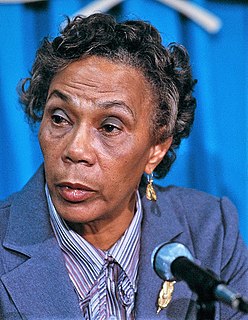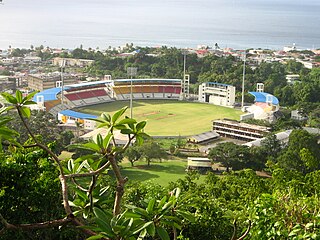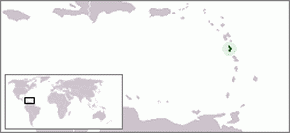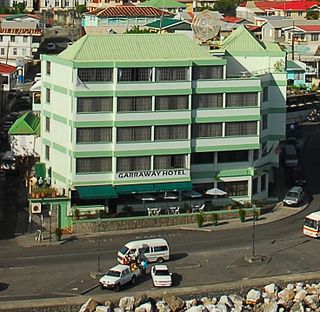Roseau is the capital and largest city of Dominica, with a population of 14,725 as of 2011. It is a small and compact urban settlement, in the Saint George parish and surrounded by the Caribbean Sea, the Roseau River and Morne Bruce. Built on the site of the ancient Island Carib village of Sairi, it is the oldest and most important urban settlement on the island of Dominica.

Dame Mary Eugenia Charles, was a Dominican politician who was Prime Minister of Dominica from 21 July 1980 until 14 June 1995. The first woman lawyer in Dominica, she was Dominica's first, and to date only, female prime minister. She was the second female prime minister in the Caribbean after Lucina da Costa of the Netherlands Antilles. She was the first woman in the Americas to be elected in her own right as head of government. She served for the longest period of any Dominican prime minister, and was the world's third longest-serving female Prime Minister, behind Sirimavo Bandaranaike of Sri Lanka and Indira Gandhi of India. She established a record for the longest continuous service of any woman Prime Minister.

Windsor Park is a multi-purpose stadium in Roseau, Dominica. It serves as the national stadium and is used mostly for cricket matches. Other uses have included the World Creole Music Festival, the Finals of the Calypso Competition and the Miss Dominica pageant.

The State House, located in Roseau, is the official residence of the President of Dominica. Previously it was used as the official residence of the colonial governors of Dominica.
Lennox Honychurch is Dominica's most noted historian and a politician. He is well known for writing 1975's The Dominica Story, the 1980s textbook series The Caribbean People, and the 1991 travel book Dominica: Isle of Adventure. Also an artist and a curator, he was largely responsible for compiling the exhibit information for The Dominica Museum in Roseau. Honychurch is the grandson of writer and politician Elma Napier.

Dominica, officially the Commonwealth of Dominica, is an island country in the Caribbean. The capital, Roseau, is located on the western side of the island. It is geographically situated as part of the Windward Islands chain in the Lesser Antilles archipelago in the Caribbean Sea. Dominica's closest neighbours are two constituent territories of the European Union and Eurozone, the overseas departments of the French Republic, Guadeloupe to the northwest and Martinique to the south-southeast. Dominica comprises a land area of 750 km2 (290 sq mi), and the highest point is Morne Diablotins, at 1,447 m (4,747 ft) in elevation. The population was 71,293 at the 2011 census.

The following is an alphabetical list of topics related to the nation of Dominica.
Tourism in Dominica consists mostly of hiking in the rain forest and visiting cruise ships.

The Cathedral of Our Lady of Fair Haven of Roseau, originally known in French as Église de Notre-Dame du Bon Port du Mouillage de Roseau, is a Roman Catholic cathedral in Roseau, the capital city of Dominica in the Caribbean. The church is the see of the Diocese of Dominica, suffragan diocese of the Archdiocese of Castries, Saint Lucia.

The British Colonial Hotel is a historic four-star or AAA four-diamond hotel in downtown Nassau, Bahamas, located on the only private beach in Nassau, on the site of the Old Fort of Nassau. The hotel, originally opened in 1924, has been described as "the Grand Dame of all Nassau hotels", "the most elegant and most expensive hotel in town", and "the most distinctive and pleasant of the island's large hotels".

Agostino Brunias was an Italian painter who was primarily active in the West Indies. Born in Rome around 1730, Brunias spent his early career as a painter after graduating from the Accademia di San Luca. After he befriended prominent Scottish architect Robert Adam and accompanied him back to Britain, Brunias left for the British West Indies to continue his career in painting under the tutelage of Sir William Young. Although he was primarily commissioned to paint the various planter families and their plantations in the West Indies, he also painted several scenes featuring free people of colour and cultural life in the West Indies. Brunias spent most of his West Indian career on the island of Dominica, where he would die in 1796. Historians have made disparate assessments of Brunias's works; some praised his subversive depiction of West Indian culture, while others claimed it romanticised the harshness of plantation life. Haitian revolutionary Toussaint Louverture was a prominent admirer of his work.

Fort Young Hotel is a hotel on the quayside of Roseau, Dominica, in the southern part of the capital next to Garraway Hotel, Dominica Museum, the Roseau Public Library, just south of the Governor's Residence and Roseau Cathedral. Located within the ramparts of the old colonial military Fort Young of 1770s vintage and built in the backdrop of a quay overlooking the Caribbean Sea, the 71-room hotel was established in 1964 and hosts a diving centre.
The Old Market of Roseau, also known as Old Market Plaza and Dawbiney Market Square, is a market located in Roseau, the capital of the Caribbean island of Dominica. Located behind what is today The Dominica Museum on the seafront, it was a thriving market during colonial times and the square was the place where all the major trading between Dominica and the surrounding islands took place, from commodities to slave trading. Public executions were held here. In 1988, the square was renovated as a craft center with shops, to display Dominica crafts. Today it contains stalls selling handcrafted jewelry, T-shirts, spices etc.

Garraway Hotel is a hotel located on the quayside of Roseau, Dominica. It lies between the Fort Young Hotel and right next to The Dominica Museum. In the colonial period this area was part of the Fort Young from 1770. This hotel was built in 1994. Located in a mint green and white building, the five-storey hotel contains 31 rooms and is operated by the Garraway family. The hotel contains an interior courtyard, rooftop terrace, the Balisier Creole cuisine restaurant on the second floor, a duty-free shop on the ground floor and the Ole Jetty Bar. The rooms are fitted with king-sized beds or double beds, with rattan furniture and floral-print fabrics.
Stock Farm Prison, also known as Her Majesty's Prison, is the national prison of the Caribbean island of Dominica. It lies in the northern part of the city of Roseau, in the Stock Farm neighborhood, just to the northwest of Dominica State College. As of 2010 it had a prison population of 289, up from 229 in 1992, which, given its size, is severely overcrowded. As of 2010 it was directed by Denis A. Blanc, under the Dominica Prison Service. A Department for International Development small grants scheme has enabled the Foreign and Commonwealth Office to launch a training programme in the prison for the convicts such as bricklaying, carpentry and plumbing to enhance their job prospects after being released.

The Palace of Inquisition, also known as the Inquisition Palace, is an eighteenth-century the seat of the Holy Office of the Inquisition in Cartagena, now in modern Colombia. Finished around 1770, it currently serves as a museum showcasing historical artifacts. Among the many historical artifacts, the museum displays torture equipment used on victims during the inquisition. These items were removed from display in 2015 prior to visits to Colombia by Pope Francis. They have since partially returned and are again on display. The museum has been described as "one of the finer buildings" in Cartagena. Cited as one of Cartagena's "best examples of late colonial, civil architecture", it faces the Parque de Bolívar.

Sylvia Judith Bertrand was a Dominican civil servant who went on to earn a law degree in Dominica and serve as the Director of Public Prosecution. She served as Solicitor General for Dominica and later as High Court Judge for Antigua and Barbuda, Saint Vincent and the Grenadines, and the British Virgin Islands on the Eastern Caribbean Supreme Court.
Doreen Paul was a Dominican banker who served in politics from 1990 to 2000. She was particularly involved, as the Minister of Health and Social Security, in the development of infrastructure improvement projects including health centers, sports complexes, roads and water systems.
Dominican nationality law is regulated by the 1978 Constitution of Dominica, as amended; the Citizenship Act, and its revisions; and various British Nationality laws. These laws determine who is, or is eligible to be, a national of Dominica. Dominican nationality is typically obtained either on the principle of jus soli, i.e. by birth in Dominica; or under the rules of jus sanguinis, i.e. by birth abroad to parents with Dominican nationality. It can also be granted to persons with an affiliation to the country, or to a permanent resident who has lived in the country for a given period of time through naturalisation. There is also, currently a program in Dominica for acquiring nationality by investment. Nationality establishes one's international identity as a member of a sovereign nation. Though it is not synonymous with citizenship, for rights granted under domestic law for domestic purposes, the United Kingdom, and thus the commonwealth, have traditionally used the words interchangeably.
Commonwealth of Dominica–France relations refers to the historical, political, economic, social and cultural relations between the Commonwealth of Dominica and the Republic of France. Sometimes referred to as "French Dominique", Dominica also shares close ties with its nearest neighbours, the overseas departments of the French Republic, Guadeloupe to the north and Martinique to the south. At present, Dominica is connected to the French islands by an inter-island express ferry. Under the auspice of the European Union both Dominica and France are tied economically via a 2008 concluded multilateral Economic Partnership Agreement (EPA) trade-deal representing many Caribbean nations under the name CARIFORUM. They are further members of: The Association of Caribbean States (ACS), the Caribbean Postal Union, the Organisation internationale de la Francophonie, the International Monetary Fund (IMF), the World Bank, and the United Nations.












